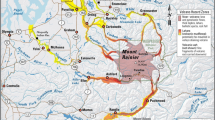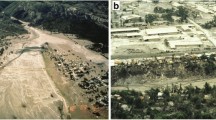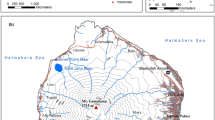Abstract
Lava flows from Mauna Loa and Hualālai volcanoes are a major volcanic hazard that could impact the western portion of the island of Hawai‘i (e.g., Kona). The most recent eruptions of these two volcanoes to affect Kona occurred in a.d. 1950 and ca. 1800, respectively. In contrast, in eastern Hawai‘i, eruptions of neighboring Kīlauea volcano have occurred frequently since 1955, and therefore have been the focus for hazard mitigation. Official preparedness and response measures are therefore modeled on typical eruptions of Kīlauea.
The combinations of short-lived precursory activity (e.g., volcanic tremor) at Mauna Loa, the potential for fast-moving lava flows, and the proximity of Kona communities to potential vents represent significant emergency management concerns in Kona. Less is known about past eruptions of Hualālai, but similar concerns exist. Future lava flows present an increased threat to personal safety because of the short times that may be available for responding.
Mitigation must address not only the specific characteristics of volcanic hazards in Kona, but also the manner in which the hazards relate to the communities likely to be affected. This paper describes the first steps in developing effective mitigation plans: measuring the current state of people’s knowledge of eruption parameters and the implications for their safety. We present results of a questionnaire survey administered to 462 high school students and adults in Kona. The rationale for this study was the long lapsed time since the last Kona eruption, and the high population growth and expansion of infrastructure over this time interval. Anticipated future growth in social and economic infrastructure in this area provides additional justification for this work.
The residents of Kona have received little or no specific information about how to react to future volcanic eruptions or warnings, and short-term preparedness levels are low. Respondents appear uncertain about how to respond to threatening lava flows and overestimate the minimum time available to react, suggesting that personal risk levels are unnecessarily high. A successful volcanic warning plan in Kona must be tailored to meet the unique situation there.

Similar content being viewed by others
References
Ajzen I (1985) From actions to intentions: a theory of planned behavior. In: J Kuhl, J Beckman (eds) Action control: from cognition to behavior. Springer, Berlin Heidelberg New York, 286 pp
Ballantyne M, Paton D, Johnston D, Kozuch M, Daly M (2000) Information on volcanic and earthquake hazards: the impact on awareness and preparation. Institute of Geological and Nuclear Sciences Science Report 2000/2, pp 1–45
Barnard WM (1995) Mauna Loa Volcano: Historical Eruptions, Exploration, and Observations (1779–1910). In: Rhodes JM, Lockwood JP (eds) Mauna Loa Revealed: Structure, Composition, History, and Hazards. Geophys Mono 92:1–19
County of Hawai‘i (2000) Hawai‘i County Data Book. Hawai‘i County Department of Research and Development. Available: http://www.hawaii-county.com/databook_current/section01.htm
Festinger L (1980) Retrospections on social psychology. Oxford University Press, New York, 297 pp
Finch RH (1926) The April 10, 1926 outbreak of Mauna Loa. In: Fiske RS, Simkin T, Nielsen EA (eds) (1987) The Volcano Letter 68. Smithsonian Institution Press, Washington, DC, 1 pp
Finch RH, Macdonald GA (1950) The June 1950 eruption of Mauna Loa. Part I. In: Fiske RS, Simkin T, Nielsen EA (eds) (1987) The Volcano Letter 508. Smithsonian Institution Press, Washington DC, pp 1–12
Gregg CE, Houghton BF, Johnston DM, Paton D, Swanson DA (2004) The perception of volcanic risk in Kona communities from Mauna Loa and Hualalai volcanoes, Hawai‘i. J Volcanol Geotherm Res 130:179–196
Hawai‘i State Civil Defense (2002) Lava flow hazard mitigation plan: reducing the risk of lava flows to life and property. Hawai‘i State Civil Defense Report 11/2002, pp 1–75
Jaggar, TA (1933) Kilauea Report. In: Fiske RS, Simkin T, Nielsen EA (eds) (1987) The Volcano Letter 406. Smithsonian Institution Press Washington, DC, pp 1–2
Kauahikaua J, Cashman KV, Clague DA, Champion D, Hagstrum JT (2002) Emplacement of the most recent lava flows on Hualalai Volcano Hawai‘i. Bull Volcanol 64:229–253
Lachman R, Bonk WJ (1960) Behavior and beliefs during the recent volcanic eruption at Kapoho, Hawai‘i. Science 131:1095–1096
Lachman R, Tatsuoka M, Bonk WJ (1961) Human behavior during the tsunami of 23 May 1960. Science 133(3462):1,405–1,409
Lockwood JP, Dvorak JJ, English TT, Koyanagi RY, Okamura AT, Summers ML, Tanigawa WR (1987) Mauna Loa 1974–1984: A decade of intrusive and extrusive activity. In: Decker RW, Wright TL, Stauffer PH (eds) Volcanism in Hawai‘i. US Geol Surv Prof Pap 1350:537–570
Macdonald GA (1954) Activity of Hawaiian volcanoes during the years 1940–1950. Bulletin Volcanologique 15:119–179, 27 plates
Macdonald GA, Abbot AT, Peterson FL (1983) Volcanoes in the Sea. University of Hawai‘i Press, Honolulu, pp 517
Menzer SS (2000) Requiring Implementation of a Natural Disaster Preparedness Program in Hawai‘i’s Public Schools. M.A. Thesis, California State University, pp 119
Mileti DS, Sorensen JH (1990) Communication of Emergency Public Warnings: a Social Science Perspective and State-of-the-Art Assessment. Federal Emergency Management Agency, Washington, DC
Mileti DS, O’Brien P (1992) Warnings during disaster: normalizing communicated risk. Social Problems 39(1):40–57
Moore RB, Clague DA, Meyer R, Bohrson WA (1987) Hualalai Volcano: a preliminary summary of geologic, petrologic and geophysical data. In: Decker RW, Wright TL, Stauffer PH (eds) Volcanism in Hawai‘i. US Geol Surv Prof Pap 1350:571–585
Mullineaux DR, Peterson DW, Crandell DR (1987) Volcanic hazards in the Hawaiian Islands. In: Decker RW, Wright TL, Stauffer PH (eds) Volcanism in Hawai‘i. US Geol Surv Prof Pap 1350:599–621
Murton BJ, Shimabukuro S (1974) Human adjustment to volcanic hazard in Puna District, Hawai‘i. In: White GF (ed) Natural hazards: Local, National, Global. Oxford University Press, New York, pp 151–159
Paton D (2000) Emergency planning: integrating community development, community resilience and hazard mitigation. J Am Soc Prof Emergency Managers 7:109–118
Paton D (2003) Disaster preparedness: a social-cognitive perspective. Disaster Prevention Management 12:210–216
Paton D, Flin R (1999) Disaster stress: an emergency management perspective. Disaster Prevention Management 8:161–167
Paton D, Smith LM, Johnston D (2000) Volcanic hazards: risk perception and preparedness. New Zealand J Psychology 29:84–88
Ronan KR, Johnston DM (2001) Correlates of hazard education programs for youth. Risk Analysis 21:1055–1063
Sorensen JH, Gersmehl PJ (1980) Volcanic hazard warning system: persistence and transferability. Environmental Management 4:125–136
Trusdell FA (1995) Lava flow hazards and risk assessment on Mauna Loa volcano, Hawai‘i. In: Rhodes JM, Lockwood JP (eds) Mauna Loa revealed: Structure, Composition, History, and Hazards. Geophys Mono 92:327–336
US Census Bureau (2000a) Census 2000 Tiger/line Data, Hawai‘i County. Available: http://arcdata.esri.com/data/tiger2000/tiger_download.cfm
US Census Bureau (2000b) American Fact Finder Quick Tables. Available: http://factfinder.census.gov/servlet/BasicFactsServlet?_basicfacts=1&_mult1=8626225&_geo2=050&_geoType1=90975465&_current=1&_action=_geoTypeSelected&_child_geo_id=&_lang=en
US Geological Survey (1997) Volcanic and seismic hazards on the Island of Hawai‘i. US Government Printing Office, pp 48
US Geological Survey (2003) New instrumentation on Mauna Loa’s southwest rift zone. Volcano Watch. August 21, 2003. Available: http://hvo.wr.usgs.gov/volcanowatch/2003/03_08_21.html
Weisel D, Stapleton F (1992) Aloha O Kalapana. Bishop Museum Press, Honolulu, pp 154
Wright TL, Chu JY, Esposo J, Heliker C, Hodge J, Lockwood JP, Vogt SM (1992) Map showing lava-flow hazard zones, Island of Hawai‘i. US Geol Surv Misc Field Studies Map MF-2193, Scale 1:250,000:1 folded map
Acknowledgements
Funding was provided by the Jaggar Bequest Fund; the USGS Volcano Hazards Program; the Center for the Study of Active Volcanoes and the Hawai‘i Sea Grant College Program. We thank J. Donnelly-Nolan, J. Smith, R. Tilling and G. Heiken for thorough reviews that significantly strengthened and shortened this manuscript. We especially thank J. Donnelly-Nolan for very insightful suggestions for future outreach.
Author information
Authors and Affiliations
Corresponding author
Rights and permissions
About this article
Cite this article
Gregg, C.E., Houghton, B.F., Paton, D. et al. Community preparedness for lava flows from Mauna Loa and Hualālai volcanoes, Kona, Hawai‘i. Bull Volcanol 66, 531–540 (2004). https://doi.org/10.1007/s00445-004-0338-x
Received:
Accepted:
Published:
Issue Date:
DOI: https://doi.org/10.1007/s00445-004-0338-x




